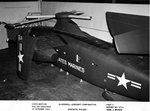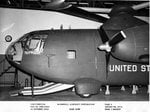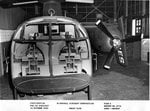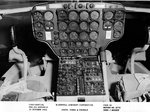Navigation
Install the app
How to install the app on iOS
Follow along with the video below to see how to install our site as a web app on your home screen.
Note: This feature may not be available in some browsers.
More options
You are using an out of date browser. It may not display this or other websites correctly.
You should upgrade or use an alternative browser.
You should upgrade or use an alternative browser.
Aircraft Mock-Ups
- Thread starter Capt. Vick
- Start date
Ad: This forum contains affiliate links to products on Amazon and eBay. More information in Terms and rules
More options
Who Replied?johnbr
2nd Lieutenant
johnbr
2nd Lieutenant
Bristol Brabazon mockup

Old Wizard
2nd Lieutenant
johnbr
2nd Lieutenant
johnbr
2nd Lieutenant
Last edited:
Old Wizard
2nd Lieutenant
johnbr
2nd Lieutenant
H145M mock-up

Interesting stuff!
Agreed.
Old Wizard
2nd Lieutenant
johnbr
2nd Lieutenant
Design of the Model 78 was started in 1950 in answer to a request for proposals for an assault transport helicopter which had been issued by the Navy Department on behalf of the US Marine Corps. Intended to operate from CVE-105 class (USS Commencement Bay) carriers, the new helicopter was to fit on 13.41m by 12.80m deck elevators. Its primary mission was to carry 30 troops to objectives up to 100 naut miles away and return to the carrier without the need to refuel ashore.
To fulfill what were then most demanding requirements, McDonnell designed a compound helicopter with a three-bladed rotor and short wings on which were mounted two 3507shp Allison XT56-A-4 turbines. For vertical flight, air from engine-driven auxiliary compressors was to be ducted to 726kg thrust McDonnell 12JP20 pressure jets, one at the extremity of each rotor. For forward flight, each engine was to drive a three-bladed propeller, with transition from helicopter flight mode to conventional flight being made by transferring power from the auxiliary compressors to the propellers as soon as the forward speed exceeded the stalled speed of the wing. Normal accommodation was to have been provided for a crew of two and 30 fully-equipped troops. Alternatively, accommodation could have been provided for 36 troops or 24 litter patients, or two Jeep-sized vehicles could have been carried internally. Larger loads (up to a maximum weight of 5224kg) could be carried externally. Another noteworthy design feature was the inclusion of a hydraulically-operated loading ramp in the forward fuselage, beneath the cockpit. Folding wings, rotor blades, and tail unit were to have enabled the Model 78 to fit on the deck elevators of CVE-105 carriers.
The Navy selected the McDonnell design on 15 March, 1951, and two and a half months later issued a Letter of Intent for three XHRH-1 prototypes (Bu Nos 133736/133738) to be built under Contract N0a(s)-51-1201. A full-scale mock-up of the XHRH-1 was inspected on 22 and 23 October, 1952, and construction of the prototypes was begun. However, after the Korean War had ended, budget cuts and concern over anticipated developmental problems led to the cancellation of the contract before completion of a single XHRH-1. All work on the project ended in April 1954.
Technical data for XHRH-1
Rotor diameter: 19.81m,
wingspan: 13.72m,
length with rotor blades and tail folded: 16.33m,
height: 5.09m,
wing area: 30.84m2,
empty weight: 8695kg,
loaded weight: 13795kg,
maximum weight: 16329kg,
maximum speed at sea level: 444km/h,
climb rate: 12m/s,
hover ceiling out of ground effect: 3050m,
combat radius: 185km
To fulfill what were then most demanding requirements, McDonnell designed a compound helicopter with a three-bladed rotor and short wings on which were mounted two 3507shp Allison XT56-A-4 turbines. For vertical flight, air from engine-driven auxiliary compressors was to be ducted to 726kg thrust McDonnell 12JP20 pressure jets, one at the extremity of each rotor. For forward flight, each engine was to drive a three-bladed propeller, with transition from helicopter flight mode to conventional flight being made by transferring power from the auxiliary compressors to the propellers as soon as the forward speed exceeded the stalled speed of the wing. Normal accommodation was to have been provided for a crew of two and 30 fully-equipped troops. Alternatively, accommodation could have been provided for 36 troops or 24 litter patients, or two Jeep-sized vehicles could have been carried internally. Larger loads (up to a maximum weight of 5224kg) could be carried externally. Another noteworthy design feature was the inclusion of a hydraulically-operated loading ramp in the forward fuselage, beneath the cockpit. Folding wings, rotor blades, and tail unit were to have enabled the Model 78 to fit on the deck elevators of CVE-105 carriers.
The Navy selected the McDonnell design on 15 March, 1951, and two and a half months later issued a Letter of Intent for three XHRH-1 prototypes (Bu Nos 133736/133738) to be built under Contract N0a(s)-51-1201. A full-scale mock-up of the XHRH-1 was inspected on 22 and 23 October, 1952, and construction of the prototypes was begun. However, after the Korean War had ended, budget cuts and concern over anticipated developmental problems led to the cancellation of the contract before completion of a single XHRH-1. All work on the project ended in April 1954.
Technical data for XHRH-1
Rotor diameter: 19.81m,
wingspan: 13.72m,
length with rotor blades and tail folded: 16.33m,
height: 5.09m,
wing area: 30.84m2,
empty weight: 8695kg,
loaded weight: 13795kg,
maximum weight: 16329kg,
maximum speed at sea level: 444km/h,
climb rate: 12m/s,
hover ceiling out of ground effect: 3050m,
combat radius: 185km
Attachments
vikingBerserker
Lieutenant General
Nice!
Old Wizard
2nd Lieutenant
johnbr
2nd Lieutenant
The YOV-10As all had the short span wings as shown on the drawing, 30 feet 4 inches versus the 40 foot span of the production aircraft. The production aircraft also had the engines and booms moved out from centre by six inches the horizontal tail was thus 12 inches wider...the Hawk/Testors kit has the 40' wings of the production type but the engine/boom spacing and horizontal tail width of the prototypes.
The other differences are that the prototypes did not have the angled weapons sponsons...they were as shown in the drawing, and a fillet was added at the base of each fin on the production version.
The floatplane version never proceeded past the mock-up stage.

The other differences are that the prototypes did not have the angled weapons sponsons...they were as shown in the drawing, and a fillet was added at the base of each fin on the production version.
The floatplane version never proceeded past the mock-up stage.
Old Wizard
2nd Lieutenant
johnbr
2nd Lieutenant
Last edited:
johnbr
2nd Lieutenant
Last edited:
Users who are viewing this thread
Total: 1 (members: 0, guests: 1)




